19 Mar 2018
Bovine respiratory disease on farm – looking past treating sick calves
Virginia Sherwin describes the diagnosis and treatment of this disease in cattle and looks at prevention methods through housing.
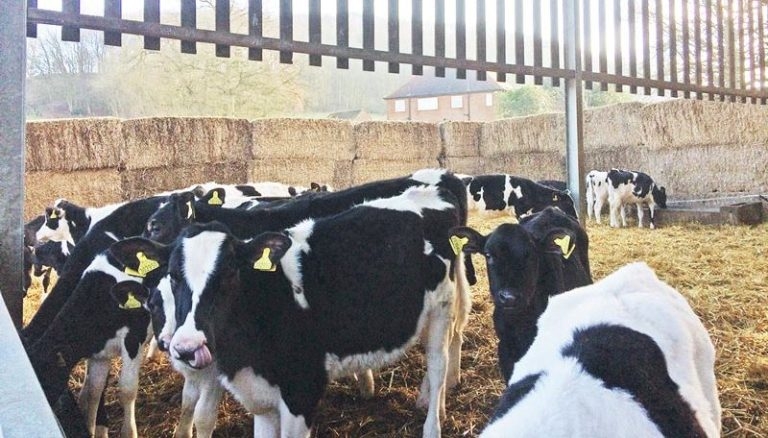
Figure 4. The calf shed has an outside area created using straw bales, which helps improve airflow and increases the available floor space.
Bovine respiratory disease (BRD) is a prevalent disease complex in calves that represents both welfare and economic issues for farmers. It is caused by multiple pathogens, often acting in a synergistic fashion.
The cost of a single case of BRD is estimated to be £23 to £43 per case1, but this is likely an underestimate as it fails to consider the impact the disease has on future performance and survival. The major contributors to cost are increased risk of mortality, treatment and decreased daily liveweight gain (DLWG), which indicates BRD is also a welfare issue.
Mortality rates of BRD have been reported up to 13.3%, and chronic cases of BRD have been shown to delay age at first calving and future survival in the adult herd2. Therefore, this is a highly prevalent disease complex that has significant consequences for farmers.
Clinical syndrome
Classic BRD presentation involves increased respiratory rate and effort, with the presence of a cough, nasal discharge and ocular discharge3. Theoretically, the calf will be pyrexic; however, during more chronic stages of the disease, fever is not always present. The classic presentation often represents chronic BRD, which involves multiple pathogens and variable amounts of lung pathology (Figure 1).
Acute BRD tends to present more as elevated respiratory rate, anorexia and fever, and can often be attributed to a single pathogen.
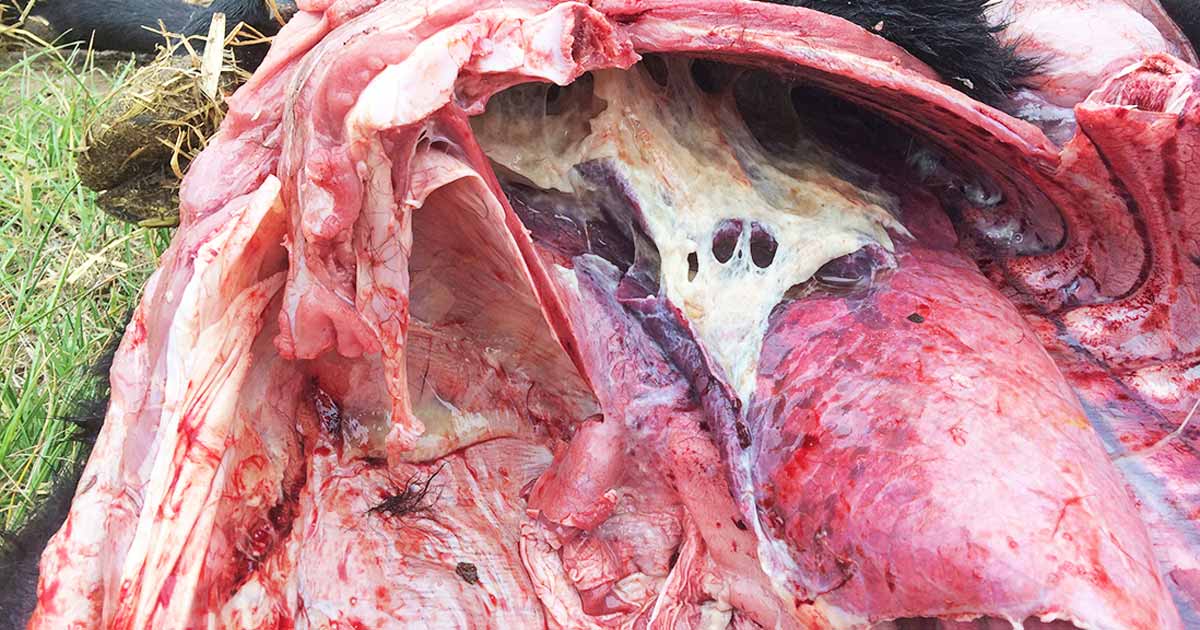
Methods of diagnosing BRD
Individual animal
Multiple methods have been used as ancillary methods to diagnose BRD, including scoring systems, whisper stethoscopes and ultrasonography. BRD tends to be polymicrobial, with many of the bacterial agents being commensals. Therefore, extensive diagnostics may not always be beneficial and can be expensive.
An important diagnostic tool is postmortem examination, which should not be performed on the chronic poor doers or repeat BRD cases as the pathology and bacteria isolated may not truly represent the initial pathogens4.
Postmortems performed on farm can also be an important tool in client education and used to persuade reluctant farmers to discuss BRD preventive measures.
Other simple on farm diagnostics include deep pharyngeal swabs, with the presence of bacterial pathogens in high numbers (greater than or equal to 106 colony-forming units/ml), significant viral agents or greater than or equal to 2 more swabs per group of 6 calves testing positive for Mycoplasma being considered significant. The aetiology of the BRD may aid treatment choice; however, the aetiology and any antibiotic sensitivity results could alter over time.
Herd level
Herd level diagnoses of a BRD problem should involve investigating the number of calves affected. The first step is to clarify what a case of BRD is for the individual farm in terms of clinical signs and treatment, as this could give an indication as to whether an under or overdiagnosing problem exists on the farm.
A proxy for BRD incidence can then be calculated using treatment records, with the number of calves in the pen for each time period as an at-risk population (Figure 2).
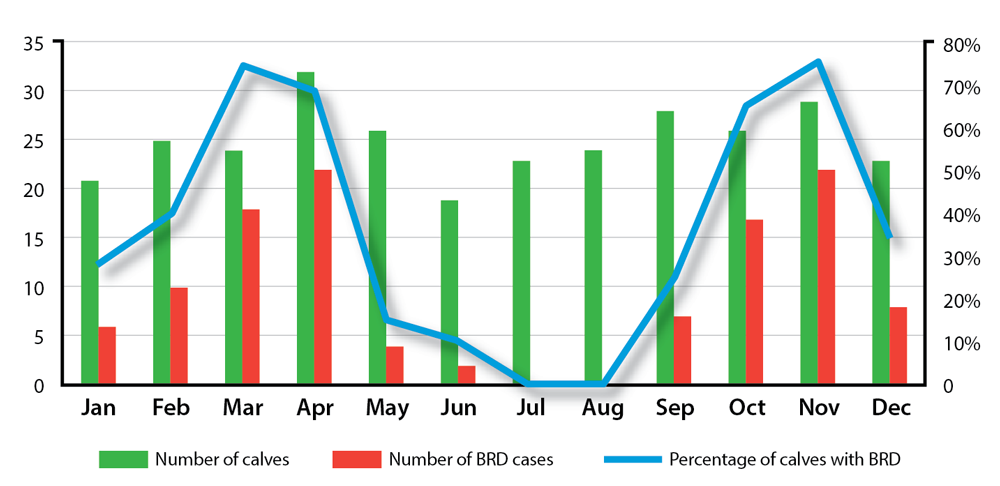
This allows for the identification of seasonal patterns, as well as initiation of investigation into possible risk factors. It can also provide information on the number of treatments required per calf and identification of chronically infected calves.
If treatment records are unreliable or unavailable, a prevalence can be calculated for that day using a scoring method such as the Wisconsin calf health scoring system.
It has a reported sensitivity of 62.4% (47.9% to 75.8%) and specificity of 74.1% (64.9% to 82.8%); this should be repeated for several time points over a large sample of calves by the same person to increase the sensitivity of the scoring system5.
Treatment
Increasing cure chances
The best method of increasing the chance of cure is through early detection of the disease, as this will help to prevent large lung pathology due to the inflammatory response and potential exotoxins released by bacterial pathogens.
The presence of lung pathology will inhibit drug penetration into the infection site and reduce the efficacy of the antimicrobial.
Use of antibiotics
Antibiotics have been relied on to treat BRD, as often a secondary bacterial infection is present at the time of disease detection. While individual antimicrobials and pathogens are outside the scope of this article, a few key questions are considered now.
What are the key considerations when selecting an antimicrobial?
Ideally, antibiotic selection should be based on isolated or suspected aetiology of the BRD. However, it is likely multiple bacteria will be present, including potentially Gram-negative bacteria (Mannheimia haemolytica, Histophilus somni and Pasteurella multocida) and Gram-positive bacteria (Mycoplasma bovis). Other key considerations when selecting an antibiotic include the spectrum of activity required, penetration into the lung tissues, ensuring compliance of the farmer (long acting versus daily injections) and whether the antibiotic is critically important6.
How long should duration of therapy be?
Information is limited regarding the length of treatment. One study showed an additional two days of treatment resulted in a higher cure rate (five days compared to three days); however, it is not possible to determine what proportion of the increased cure rate was related to the additional therapy, compared to the additional time allowed for recovery in this study6. However, a longer course of antibiotics tends to be recommended to increase the chance of success.
Should I use a combination of antibiotics or switch them for recurrent cases?
This is not usually necessary as, in most cases that are not responding (15% to 25% of BRD cases treated), it is likely additional duration of treatment is required, rather than an alternative antibiotic.
If a high number of repeat cases occurs on the farm, look at evaluating other factors such as time of detection, ancillary treatments and accuracy of diagnosis7.
What about Mycoplasma?
The role of M bovis as a primary respiratory pathogen is still debated, but little doubt exists about the involvement of this organism in chronic respiratory disease.
M bovis is a Gram-positive bacteria deficient of a cell wall and can hide from the immune system by adhering to host cells, including tracheobronchial epithelial cells. M bovis is best recognised as a cause of chronic pneumonia that often progresses to fatal disease, despite prolonged therapy with multiple antibiotics, with characteristic gross pulmonary lesions of caseonecrotic bronchopneumonia8.
One drawback with antibiotic treatment is drug distribution is limited into the caseous foci, where most of the M bovis are. Antibiotics that have been reported to have a good minimum inhibitory concentration against M bovis in vitro include florfenicol, tulathromycin and enrofloxacin.
An important consideration when dealing with a potential Mycoplasma-related BRD problem includes whether mycoplasma is the causative pathogen, as many healthy calves can test positive for mycoplasma, with certain diagnostics including nasal swabs and serology. The most reliable detection method is via postmortem examination and culture of caseous material from the lungs.
Use of NSAIDs
One of the major pathophysiological consequences of BRD is lung damage due to the inflammatory response, which results in the classical presentation of fever, depression, anorexia and abnormal respiratory function. Research has shown, despite successful treatment, chronic lung pathology often exists, which can impair future performance and, therefore, the use of NSAIDs has been recommended.
A meta-analysis looking at randomised control trials using NSAIDs as an ancillary treatment for BRD showed the use of NSAIDs resulted in a more rapid decrease in rectal temperature in all studies, but only decreased the proportion of treatment failures in one out of the five studies analysed, and had no effect on mortality9.
However, this should not dissuade from the use of NSAIDs, as consistent, reliable studies are lacking in this area and no negative outcomes have been reported.
The use of NSAIDs alone has been suggested for the treatment of BRD in calves, as many initial cases of BRD are primarily viral and only complicated by later/secondary bacterial infection. However, detection of early stage viral BRD clinically is difficult. A randomised positive control study comparing the efficacy of NSAID treatment to antibiotic treatment for an undifferentiated fever (ear canal temperature greater than or equal to 39.7°C) showed calves treated with NSAIDs only were five times more likely to require additional antibiotic treatment at 72 hours, compared to the antibiotic-only treatment group in which 64.7% resolution of fever was seen (compared to 25.7% for NSAID treatment only)10.
It should, however, be noted this does not mean NSAID-only treatment has no place, as the differences between the two groups could have been related to the aetiology of disease on the two farms, or poor sensitivity in the detection method, resulting in detection of later-stage BRD.
The use of NSAIDs alone in this study did not affect the number of relapses, nor the growth rates of the calves in that group, compared to those that received antibiotics; therefore, the use of NSAIDs and antibiotics in conjunction is generally recommended.
Prevention
Prevention of BRD revolves around two key aspects – reducing the infection pressure within the environment (housing and management), and boosting the immune system and general health of the calf.
Housing
Air quality and ventilation
The bacterial count of the air is used as a proxy for air quality, with research showing links between increased bacterial counts in the air in the calf’s micro-environment and the incidence of BRD11. The majority of the bacteria are non-pathogenic or dead, which acts as a burden on the respiratory tract defences, increasing susceptibility to infections. Risk factors for increased bacterial counts include high temperature humidity index and high stocking densities.
High stocking densities alter the ventilation requirements, with a twofold increase in stocking density reportedly requiring a tenfold increase in ventilation capacity to maintain similar pathogenic bacterial loads. Improving ventilation can be done using natural passive ventilation and/or positive pressure ventilation (PPV).
The recommended required airflow is 4 air turns per hour in winter and 30 air turns per hour in summer. PPV systems include the use of air tubes (Figure 3) and fans that draw air into or out of the shed. These can provide approximately 0.028m3/min of additional air per calf. Where PPV is not possible, alterations of the shed can help improve air quality, including increasing both the inlet and outlet of the barn. Methods include cutting slits into the roof, replacing Yorkshire boarding or solid walls with galebreaker sides and having outside areas to the group housing (Figure 4) to increase the amount of fresh air entering the building.
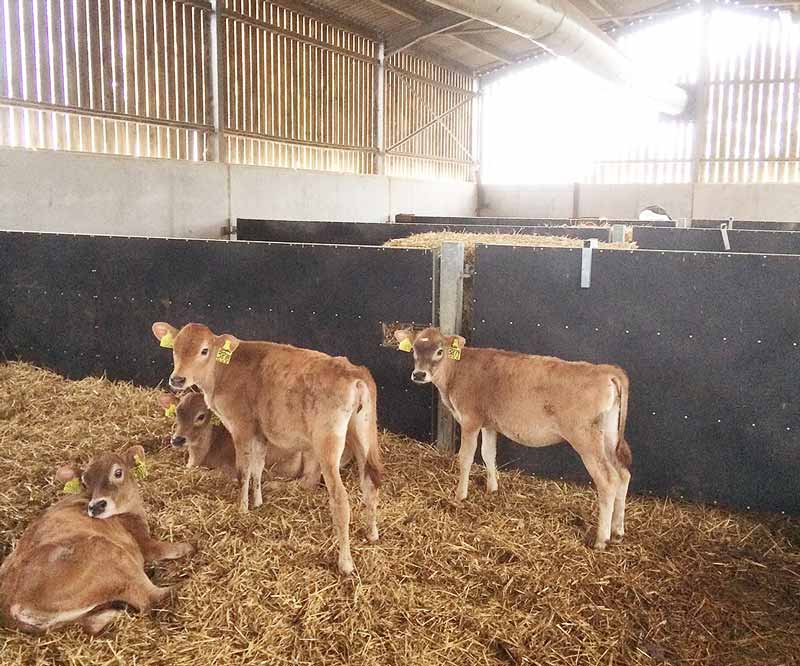
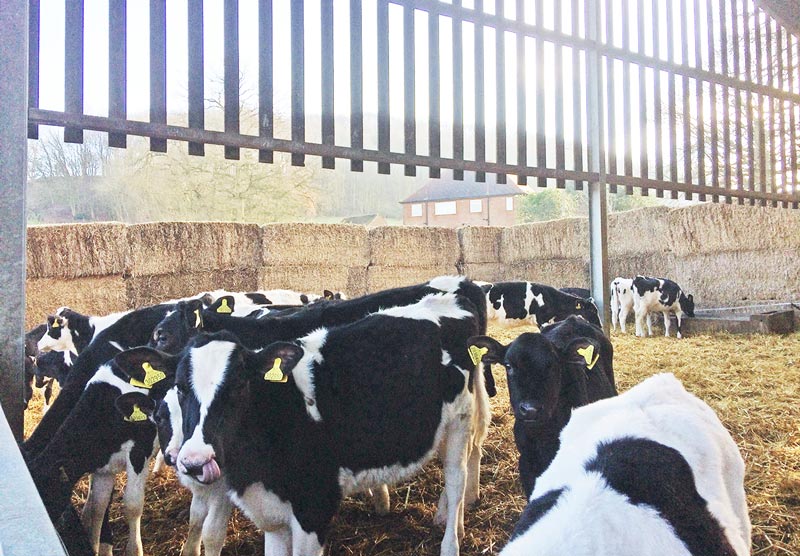
Group housing
While group housing has been shown to be beneficial for the welfare and behavioural development of calves, it can prove to be a challenge in terms of disease. Large groups of calves with a wide age range in the same airspace has been shown to be a risk factor for BRD.
The recommended stocking density for calves less than 100kg is 3m² per calf (minimum 1.5m²), with ideally 8 to 12 calves per pen, which were born within 2 weeks of each other. The age range within a pen should be considered in terms of both floor and air space. One option to aid reducing a wide range of ages in the same air space is the use of outdoor hutches.
Combating cold stress
Another aspect of housing is the impact of cold stress on calves – in terms of both poor growth rates and incidence of disease. It has been shown cold stress (reported as 4.7°C and 68.2% humidity) during the pre-weaning period resulted in increased respiratory scores and antibiotic treatments compared to calves not suffering from cold stress (15.5°C and 59% humidity).
Many methods are available in attempting to combat cold stress, including the use of sheltered areas, calf jackets, deep straw for nesting and using straw bales to prevent drafts (Figure 5).
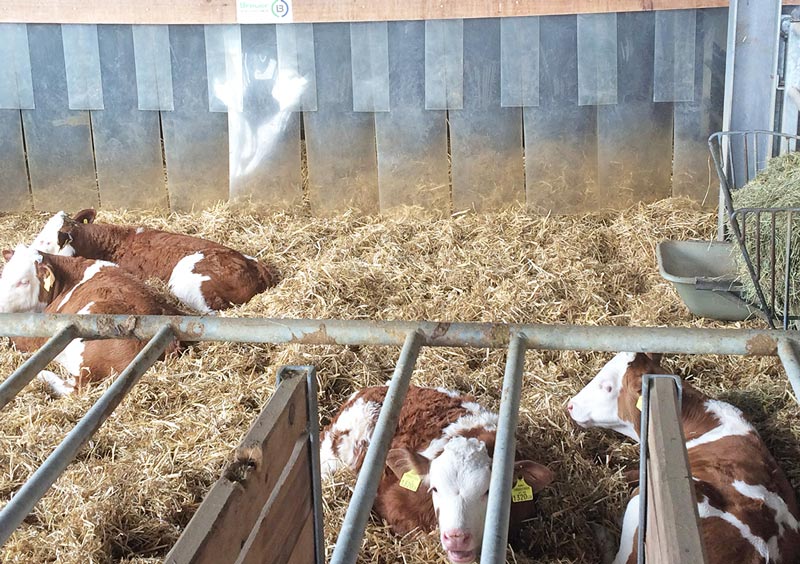
Care should be taken when using poor man’s hutches or false ceilings as calves are able to ventilate the small space and, if no outlet exists, the recirculation of air can result in an increased bacterial count within the airspace and an increased risk of BRD.
Consideration should be given to the materials the pen is made from, as metal and concrete are good heat absorbers.
The use of rubber, plastic and straw to construct the calf pens can, therefore, help reduce heat loss.
Boosting the immune system
The other aspect of BRD prevention is improving the immune function of the calf, which is achieved primarily through colostrum management, vaccination and stress management.
Calves are born immunologically naive and, therefore, colostrum provides antibodies (IgG, IgM and IgA), as well as white blood cells and cytokines. The colostral cells are important in terms of defence against pathogens, but also in ensuring the correct vaccine response12. Colostrum management should be investigated as part of an investigation into BRD.
The primary aim of vaccination is to boost the immunity of the calves at a herd level and increase the relative resistance of the individual. The vaccination protocol initiated, with respect to the type of vaccine and the timing/route of administration, will depend on the prevalence of specific pathogens and the age at which calves are usually infected.
Most respiratory vaccines are multivalent, with the aim of reducing the number of injections, broadening protection and reducing the overall cost. Sherwin and Down reviewed the use of respiratory vaccines13.
For protection against BRD in pre-weaned calves (less than six to eight weeks), the intranasal vaccines offer the most immediate protection and can be given at a younger age; however, this is only local protection and lasts 60 days. These vaccines can be used in the face of an outbreak as an immunological response is shown in three to four days.
Parental vaccines tend to require a more mature immune system to be effective and, therefore, are given at an older age and require a course of vaccines for maximum efficacy. Parental vaccines may not be suitable for protection in younger calves; however, they do provide a longer period of protection into the post-weaning period as they stimulate the development of memory cells.
Stress causes a rise in cortisol levels, which suppresses the immune system and increases susceptibility to disease, including BRD. Methods of decreasing stress should be considered as part of BRD management, including maintaining a consistent management routine, minimal group changes, avoiding multiple stresses at once and step weaning.
Conclusion
BRD is a multifactorial complex that has both welfare and economic implications at an individual animal and herd level. Thorough monitoring of data regarding the disease is required, as this allows the investigation of potential risk factors and to monitor the success of any preventive measures implemented.
